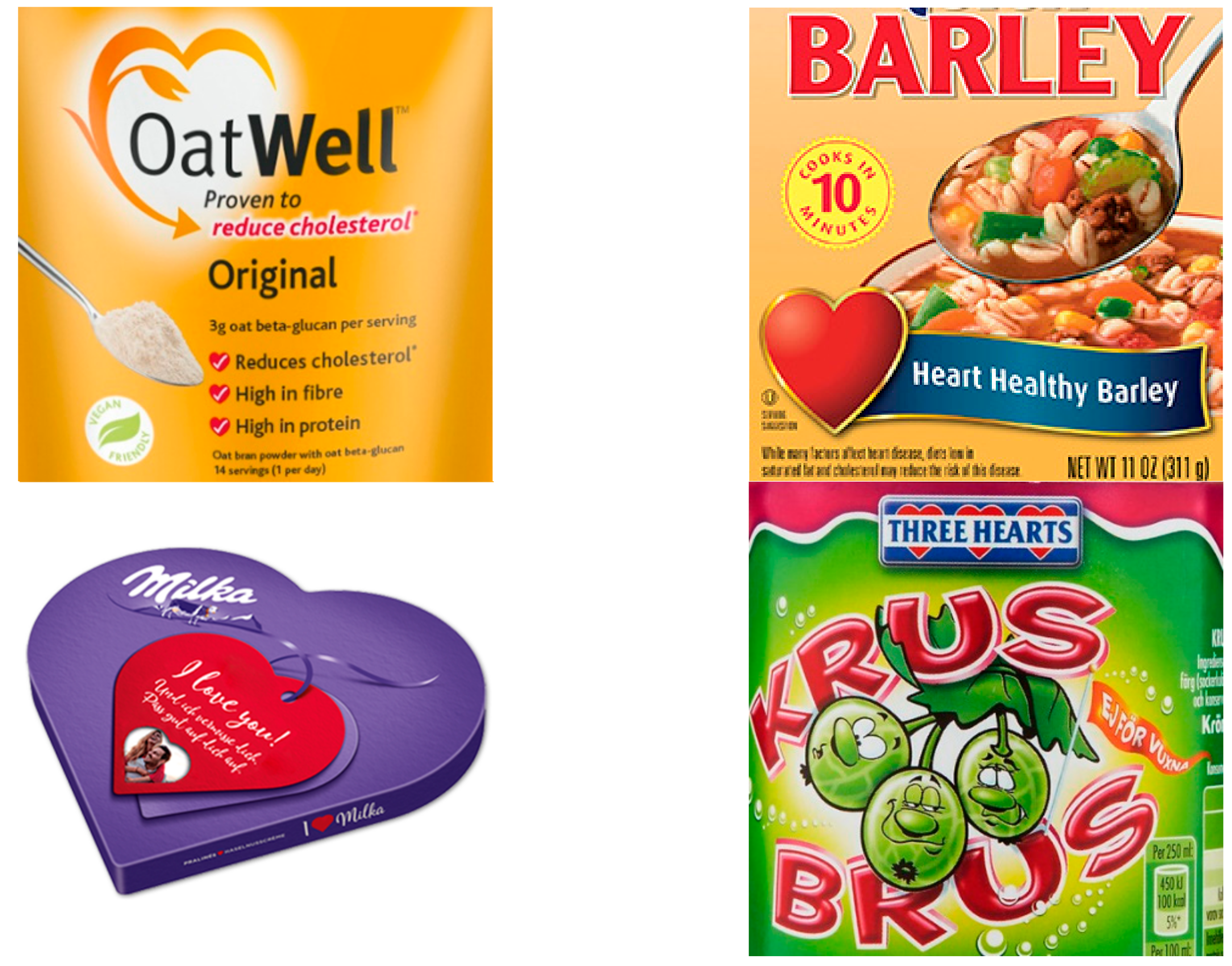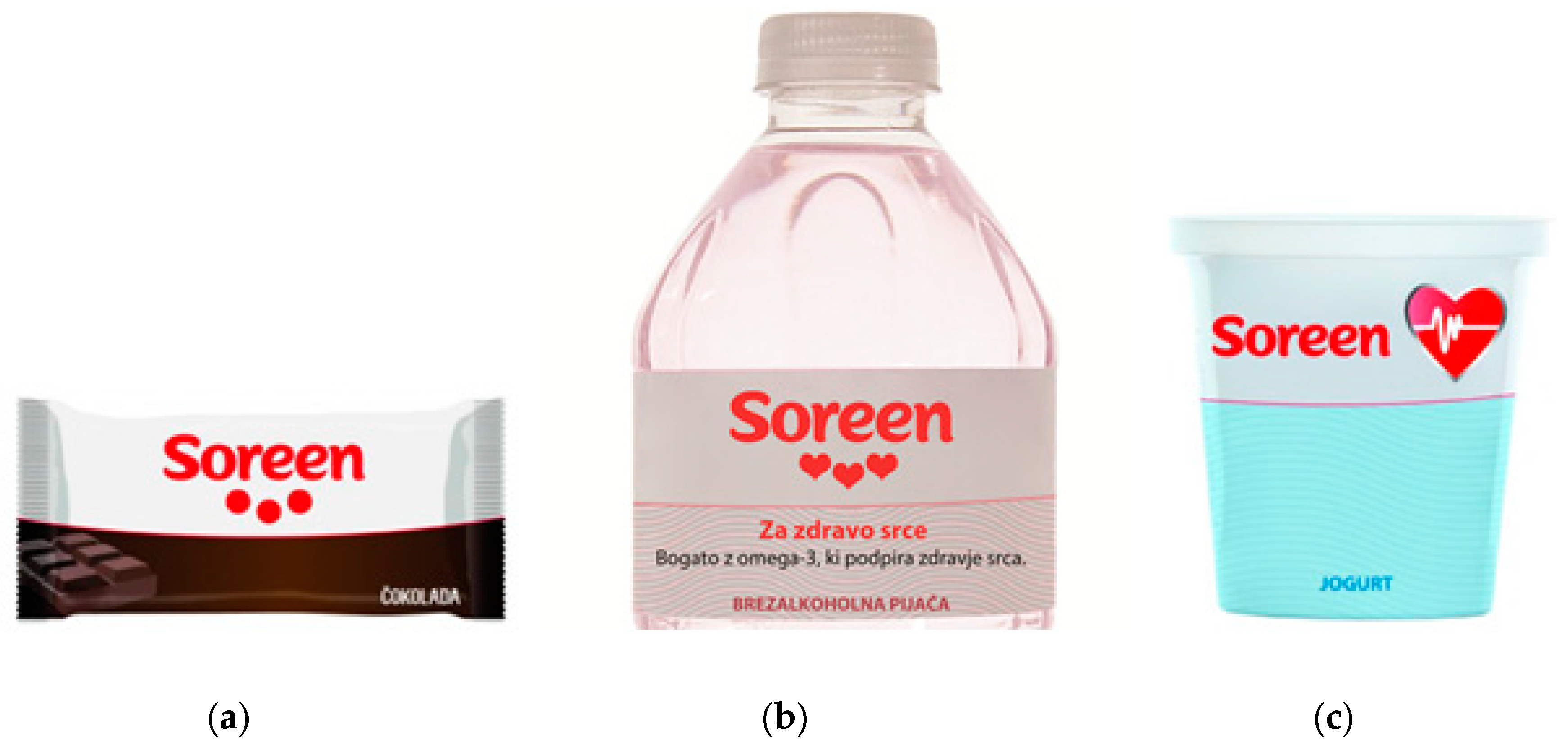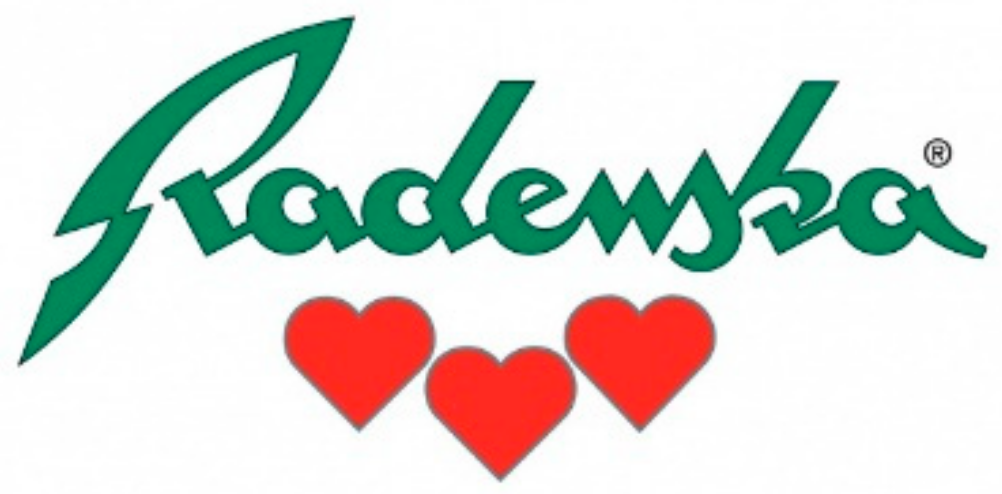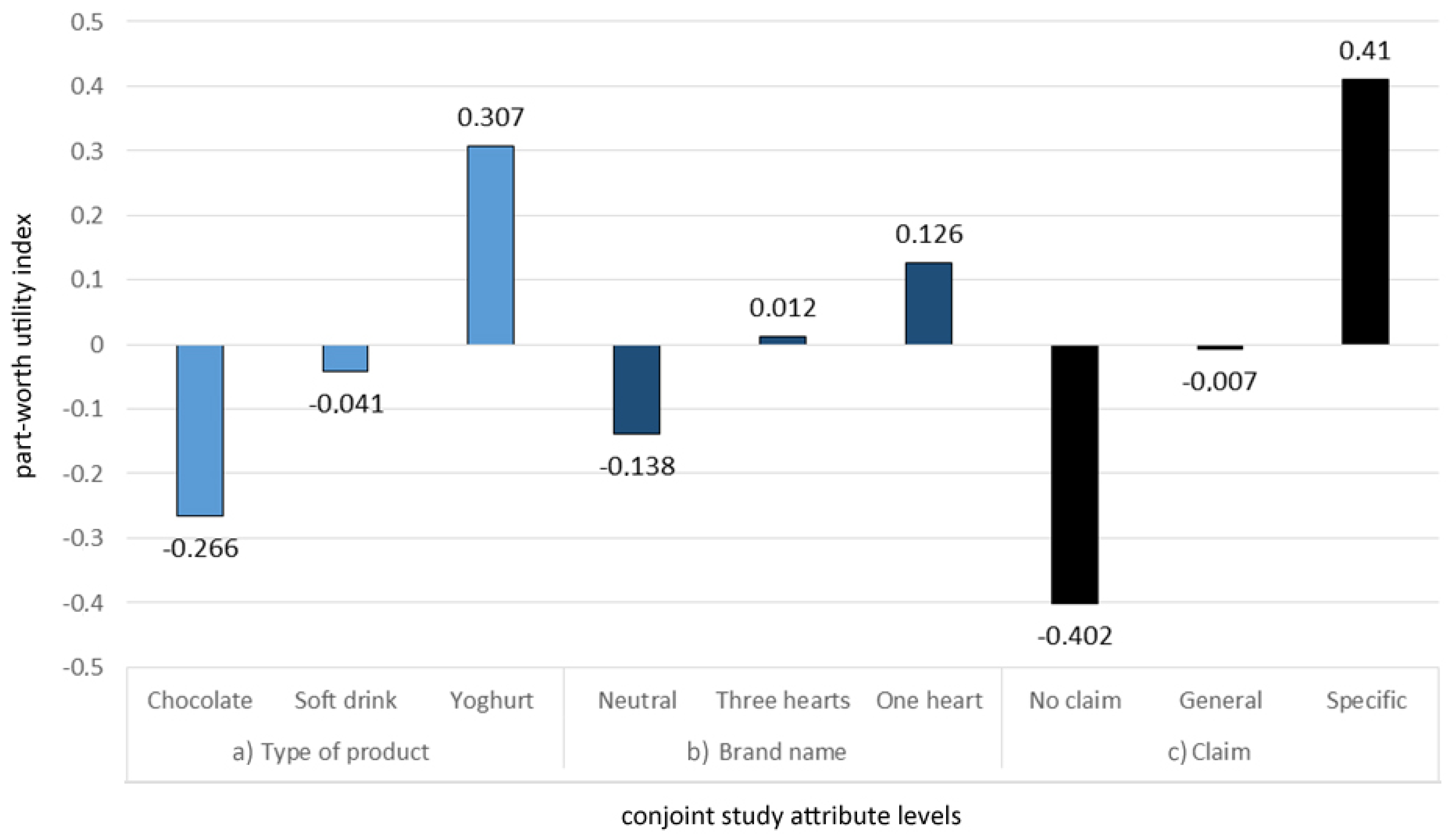Heart Images on Food Labels: A Health Claim or Not?
Abstract
1. Introduction
2. Methodology
2.1. Food Supply Study: Penetration of Heart Images/Symbols on Food Labels
2.2. Consumer Study
2.2.1. Conjoint Analysis
2.2.2. Choice-Based Task with Real-Life Elements
2.2.3. Word-Association Task
2.3. Data Processing and Statistical Analyses
3. Results and Discussion
3.1. Use of Heart Images on Food Labels
3.2. Consumer Study
4. Conclusions and Policy Applications
Supplementary Materials
Author Contributions
Funding
Data Availability Statement
Acknowledgments
Conflicts of Interest
References
- Shangguan, S.; Afshin, A.; Shulkin, M.; Ma, W.; Marsden, D.; Smith, J.; Saheb-Kashaf, M.; Shi, P.; Micha, R.; Imamura, F.; et al. A Meta-Analysis of Food Labeling Effects on Consumer Diet Behaviors and Industry Practices. Am. J. Prev. Med. 2019, 56, 300–314. [Google Scholar] [CrossRef]
- EC. Commission Regulation (EC) No 1924/2006 of 20 December 2006 on Nutrition and Health Claims Made on Foods. 2006. Available online: http://eur-lex.europa.eu/LexUriServ/LexUriServ.do?uri=CONSLEG:2006R1924:20121129:EN:PDF (accessed on 17 December 2020).
- Hieke, S.; Kuljanic, N.; Pravst, I.; Miklavec, K.; Kaur, A.; Brown, K.A.; Egan, B.M.; Pfeifer, K.; Gracia, A.; Rayner, M. Prevalence of Nutrition and Health-Related Claims on Pre-Packaged Foods: A Five-Country Study in Europe. Nutrients 2016, 8, 137. [Google Scholar] [CrossRef] [PubMed]
- EU. Commission Regulation (EU) No 432/2012 Establishing a List of Permitted Health Claims Made on Foods, Other than Those Referring to the Reduction of Disease Risk and to Children’s Development and Health. Available online: https://eur-lex.europa.eu/legal-content/EN/TXT/PDF/?uri=CELEX:02012R0432-20170822&qid=1598860651032 (accessed on 31 August 2020).
- Brecher, S.J.; Bender, M.M.; Wilkening, V.L.; McCabe, N.M.; Anderson, E.M. Status of nutrition labeling, health claims, and nutrient content claims for processed foods: 1997 Food Label and Package Survey. J. Am. Diet. Assoc. 2000, 100, 1057–1062. [Google Scholar] [CrossRef]
- Colby, S.E.; Johnson, L.; Scheett, A.; Hoverson, B. Nutrition marketing on food labels. J. Nutr. Educ. Behav. 2010, 42, 92–98. [Google Scholar] [CrossRef] [PubMed]
- Sacco, J.E.; Sumanac, D.; Tarasuk, V. Front-of-package references to fiber on foods in Canadian supermarkets highlight the need for increased nutrition knowledge among consumers. J. Nutr. Educ. Behav. 2013, 45, 518–524. [Google Scholar] [CrossRef] [PubMed]
- Schermel, A.; Emrich, T.E.; Arcand, J.; Wong, C.L.; L’Abbe, M.R. Nutrition marketing on processed food packages in Canada: 2010 Food Label Information Program. Appl. Physiol. Nutr. Metab. Physiol. Appl. Nutr. Metab. 2013, 38, 666–672. [Google Scholar] [CrossRef] [PubMed]
- Williams, P.; Yeatman, H.; Zakrzewski, S.; Aboozaid, B.; Henshaw, S.; Ingram, K.; Rankine, A.; Walcott, S.; Ghani, F. Nutrition and related claims used on packaged Australian foods—implications for regulation. Asia Pac. J. Clin. Nutr. 2003, 12, 138–150. [Google Scholar] [PubMed]
- Williams, P.; Yeatman, H.; Ridges, L.; Houston, A.; Rafferty, J.; Ridges, A.; Roesler, L.; Sobierajski, M.; Spratt, B. Nutrition function, health and related claims on packaged Australian food product—sprevalence and compliance with regulations. Asia Pac. J. Clin. Nutr. 2006, 15, 10–20. [Google Scholar]
- Devi, A.; Eyles, H.; Rayner, M.; Ni Mhurchu, C.; Swinburn, B.; Lonsdale-Cooper, E.; Vandevijvere, S. Nutritional quality, labelling and promotion of breakfast cereals on the New Zealand market. Appetite 2014, 81, 253–260. [Google Scholar] [CrossRef]
- Hughes, C.; Wellard, L.; Lin, J.; Suen, K.L.; Chapman, K. Regulating health claims on food labels using nutrient profiling: What will the proposed standard mean in the Australian supermarket? Public Health Nutr. 2013, 16, 2154–2161. [Google Scholar] [CrossRef]
- Walker, K.Z.; Woods, J.L.; Rickard, C.A.; Wong, C.K. Product variety in Australian snacks and drinks: How can the consumer make a healthy choice? Public Health Nutr. 2008, 11, 1046–1053. [Google Scholar] [CrossRef]
- Lalor, F.; Kennedy, J.; Flynn, M.A.T.; Wall, P.G. A study of nutrition and health claims—A snapshot of what’s on the Irish market. Public Health Nutr. 2010, 13, 704–711. [Google Scholar] [CrossRef]
- Kaur, A.; Scarborough, P.; Matthews, A.; Payne, S.; Mizdrak, A.; Rayner, M. How many foods in the UK carry health and nutrition claims, and are they healthier than those that do not? Public Health Nutr. 2016, 19, 988–997. [Google Scholar] [CrossRef] [PubMed]
- Pravst, I.; Kušar, A. Consumers’ Exposure to Nutrition and Health Claims on Pre-Packed Foods: Use of Sales Weighting for Assessing the Food Supply in Slovenia. Nutrients 2015, 7, 9353–9368. [Google Scholar] [CrossRef]
- Roe, B.; Levy, A.S.; Derby, B.M. The impact of health claims on consumer search and product evaluation outcomes: Results from FDA experimental data. J. Public Policy Mark. 1999, 18, 89–105. [Google Scholar] [CrossRef]
- Leathwood, P.D.; Richardson, D.P.; Sträter, P.; Todd, P.M.; van Trijp, H.C.M. Consumer understanding of nutrition and health claims: Sources of evidence. Br. J. Nutr. 2007, 98, 474–484. [Google Scholar] [CrossRef]
- Verbeke, W.; Scholderer, J.; Lähteenmäki, L. Consumer appeal of nutrition and health claims in three existing product concepts. Appetite 2009, 52, 684–692. [Google Scholar] [CrossRef] [PubMed]
- Hodgkins, C.E.; Egan, B.; Peacock, M.; Klepacz, N.; Miklavec, K.; Pravst, I.; Pohar, J.; Gracia, A.; Groeppel-Klein, A.; Rayner, M.; et al. Understanding How Consumers Categorise Health Related Claims on Foods: A Consumer-Derived Typology of Health-Related Claims. Nutrients 2019, 11, 539. [Google Scholar] [CrossRef] [PubMed]
- Banks, A.P.; Egan, B.; Hodgkins, C.E.; Peacock, M.; Raats, M.M. The role of causal models and beliefs in interpreting health claims. Br. J. Health Psychol. 2018, 23, 933–948. [Google Scholar] [CrossRef] [PubMed]
- Verhagen, H.; van Loveren, H. Status of nutrition and health claims in Europe by mid 2015. Trends Food Sci. Technol. 2016, 56, 39–45. [Google Scholar] [CrossRef]
- Sanlier, N. Evaluation of food purchasing behaviour of consumers from supermarkets. Br. Food J. 2010, 112, 140–150. [Google Scholar] [CrossRef]
- Shehzad, U.; Ahmad, S.; Iqbal, K.; Nawaz, M.; Usman, S. Influence of Brand Name on Consumer Choice & Decision. IOSR J. Bus. Manag. 2014, 16, 72–76. [Google Scholar]
- Zhang, Y. The Impact of Brand Image on Consumer Behavior: A Literature Review. Open J. Bus. Manag. 2015, 3, 58. [Google Scholar] [CrossRef]
- Gardner, B.B.; Levy, S.J. The Product and the Brand (1955). In Brands, Consumers, Symbols, & Research; Levy, S.J., Rook, D.W., Eds.; SAGE Publications, Inc.: Thousand Oaks, CA, USA, 1999; pp. 131–140. [Google Scholar]
- Gaustad, T.; Samuelsen, B.M.; Warlop, L.; Fitzsimons, G.J. Too much of a good thing? Consumer response to strategic changes in brand image. Int. J. Res. Mark. 2019, 36, 264–280. [Google Scholar] [CrossRef]
- Klepacz, N.A.; Nash, R.A.; Egan, M.B.; Hodgkins, C.E.; Raats, M.M. When is an image a health claim? A false-recollection method to detect implicit inferences about products’ health benefits. Health Psychol. 2016, 35, 898–907. [Google Scholar] [CrossRef] [PubMed]
- Radenska. Radenska—About Us. Available online: https://www.radenska.si/en/about-us (accessed on 9 January 2020).
- Lavriša, Ž.; Pravst, I. Marketing of Foods to Children through Food Packaging Is Almost Exclusively Linked to Unhealthy Foods. Nutrients 2019, 11, 1128. [Google Scholar] [CrossRef] [PubMed]
- Dunford, E.; Webster, J.; Metzler, A.B.; Czernichow, S.; Ni Mhurchu, C.; Wolmarans, P.; Snowdon, W.; L’Abbe, M.; Li, N.; Maulik, P.K.; et al. International collaborative project to compare and monitor the nutritional composition of processed foods. Eur. J. Prev. Cardiol. 2012, 19, 1326–1332. [Google Scholar] [CrossRef] [PubMed]
- Lombard, M.; Snyder-Duch, J.; Bracken, C.C. Content analysis in mass communication: Assessment and reporting of intercoder reliability. Hum. Commun. Res. 2002, 28, 587–604. [Google Scholar] [CrossRef]
- Green, P.E.; Srinivasan, V. Conjoint Analysis In Consumer Research—Issues And Outlook. J. Consum. Res. 1978, 5, 103–123. [Google Scholar] [CrossRef]
- Gębski, J.; Jezewska-Zychowicz, M.; Szlachciuk, J.; Kosicka-Gębska, M. Impact of nutritional claims on consumer preferences for bread with varied fiber and salt content. Food Qual. Prefer. 2019, 76, 91–99. [Google Scholar] [CrossRef]
- Miklavec, K.; Pravst, I.; Grunert, K.G.; Klopčič, M.; Pohar, J. The influence of health claims and nutritional composition on consumers’ yoghurt preferences. Food Qual. Prefer. 2015, 43, 26–33. [Google Scholar] [CrossRef]
- Annunziata, A.; Vecchio, R. Consumer perception of functional foods: A conjoint analysis with probiotics. Food Qual. Prefer. 2013, 28, 348–355. [Google Scholar] [CrossRef]
- Ares, G.; Gimenez, A.; Deliza, R. Influence of three non-sensory factors on consumer choice of functional yogurts over regular ones. Food Qual. Prefer. 2010, 21, 361–367. [Google Scholar] [CrossRef]
- Ares, G.; Gimenez, A.; Gambaro, A. Consumer perceived healthiness and willingness to try functional milk desserts. Influence of ingredient, ingredient name and health claim. Food Qual. Prefer. 2009, 20, 50–56. [Google Scholar] [CrossRef]
- Bech-Larsen, T.; Grunert, K.G. The perceived healthiness of functional foods—A conjoint study of Danish, Finnish and American consumers’ perception of functional foods. Appetite 2003, 40, 9–14. [Google Scholar] [CrossRef]
- Dean, M.; Lampila, P.; Shepherd, R.; Arvola, A.; Saba, A.; Vassallo, M.; Claupein, E.; Winkelmann, M.; Lahteenmaki, L. Perceived relevance and foods with health-related claims. Food Qual. Prefer. 2012, 24, 129–135. [Google Scholar] [CrossRef]
- Drewnowski, A.; Moskowitz, H.; Reisner, M.; Krieger, B. Testing consumer perception of nutrient content claims using conjoint analysis. Public Health Nutr. 2010, 13, 688–694. [Google Scholar] [CrossRef]
- Johansen, S.B.; Naes, T.; Oyaas, J.; Hersleth, M. Acceptance of calorie-reduced yoghurt: Effects of sensory characteristics and product information. Food Qual. Prefer. 2010, 21, 13–21. [Google Scholar] [CrossRef]
- Carrillo, E.; Fiszman, S.; Lähteenmäki, L.; Varela, P. Consumers’ perception of symbols and health claims as health-related label messages. A cross-cultural study. Food Res. Int. 2014, 62, 653–661. [Google Scholar] [CrossRef]
- EC. European Union Register of Nutrition and Health Claims Made on Food. Available online: https://ec.europa.eu/food/safety/labelling_nutrition/claims/register/public/?event=search (accessed on 16 March 2021).
- Roininen, K.; Arvola, A.; Lähteenmäki, L. Exploring consumers’ perceptions of local food with two different qualitative techniques: Laddering and word association. Food Qual. Prefer. 2006, 17, 20–30. [Google Scholar] [CrossRef]
- Donoghue, S. Projective techniques in consumer research. Tydskrif vir Gesinsekologie en Verbruikerswetenskappe 2000, 28, 47–53. [Google Scholar] [CrossRef]
- Wagner, W.; Valencia, J.; Elejabarrieta, F. Relevance, discourse and the ‘hot’ stable core social representations—A structural analysis of word associations. Br. J. Soc. Psychol. 1996, 35, 331–351. [Google Scholar] [CrossRef]
- Esmerino, E.A.; Ferraz, J.P.; Filho, E.R.T.; Pinto, L.P.F.; Freitas, M.Q.; Cruz, A.G.; Bolini, H.M.A. Consumers’ perceptions toward 3 different fermented dairy products: Insights from focus groups, word association, and projective mapping. J. Dairy Sci. 2017, 100, 8849–8860. [Google Scholar] [CrossRef]
- Miklavec, K.; Pravst, I.; Raats, M.M.; Pohar, J. Front of package symbols as a tool to promote healthier food choices in Slovenia: Accompanying explanatory claim can considerably influence the consumer’s preferences. Food Res. Int. 2016, 90, 235–243. [Google Scholar] [CrossRef] [PubMed]
- Ares, G.; Deliza, R. Studying the influence of package shape and colour on consumer expectations of milk desserts using word association and conjoint analysis. Food Qual. Prefer. 2010, 21, 930–937. [Google Scholar] [CrossRef]
- Pravst, I.; Kušar, A.; Miklavec, K.; Hieke, S.; Raats, M.; Rayner, M. Chapter 5 Use of Nutrition and Health Claims and Symbols on Prepacked Foods in Europe: From Consumer Exposure to Public Health Implications. In Health Claims and Food Labelling; The Royal Society of Chemistry: London, UK, 2020; pp. 79–93. [Google Scholar]
- Ballco, P.; Caputo, V.; de-Magistris, T. Consumer valuation of European nutritional and health claims: Do taste and attention matter? Food Qual. Prefer. 2020, 79, 103793. [Google Scholar] [CrossRef]
- Fenko, A.; Lotterman, H.; Galetzka, M. What’s in a name? The effects of sound symbolism and package shape on consumer responses to food products. Food Qual. Prefer. 2016, 51, 100–108. [Google Scholar] [CrossRef]
- Velasco Vizcaíno, F.; Velasco, A. The battle between brands and nutritional labels: How brand familiarity decreases consumers’ alertness toward traffic light nutritional labels. J. Bus. Res. 2019, 101, 637–650. [Google Scholar] [CrossRef]
- Ward, L.A.; Cain, O.L.; Mullally, R.A.; Holliday, K.S.; Wernham, A.G.H.; Baillie, P.D.; Greenfield, S.M. Health beliefs about bottled water: A qualitative study. Bmc Public Health 2009, 9, 196. [Google Scholar] [CrossRef] [PubMed]
- Etale, A.; Jobin, M.; Siegrist, M. Tap versus bottled water consumption: The influence of social norms, affect and image on consumer choice. Appetite 2018, 121, 138–146. [Google Scholar] [CrossRef] [PubMed]
- Danesi, M. Brands and Logos. In Encyclopedia of Language & Linguistics, 2nd ed.; Brown, K., Ed.; Elsevier: Oxford, UK, 2006; pp. 109–116. [Google Scholar]
- Hunt, S.D. The ethics of branding, customer-brand relationships, brand-equity strategy, and branding as a societal institution. J. Bus. Res. 2019, 95, 408–416. [Google Scholar] [CrossRef]
- STAT. Usage of Internet in Households and by Individuals, Slovenia. 2019. Available online: https://www.stat.si/StatWeb/en/news/Index/8423 (accessed on 2 March 2021).




| Number of Participants (%) | |
|---|---|
| Gender | |
| Male | 513 (51%) |
| Female | 487 (49%) |
| Age | |
| 18–24 | 110 (11%) |
| 25–34 | 195 (20%) |
| 35–44 | 221 (22%) |
| 45–54 | 235 (24%) |
| 55–65 | 239 (24%) |
| Education | |
| Primary school or less | 17 (2%) |
| Vocabulary school | 102 (10%) |
| High school | 379 (38%) |
| University | 502 (50%) |
| Diet type | |
| Regular (mixed) | 932 (93%) |
| Vegetarian | 43 (4%) |
| Vegan | 12 (1%) |
| Other | 13 (1%) |
| Regular consumers 1 of selected foods | |
| Fruits | 556 (56%) |
| Vegetables | 567 (57%) |
| Meats | 231 (23%) |
| Milk and dairy products | 361 (36%) |
| Tap water | 899 (90%) |
| Bottled water | 121 (12%) |
| Soft drinks | 141 (14%) |
| Total | 1000 |
| Attribute | Attribute Level |
|---|---|
| Type of product | Soft drink |
| Yoghurt | |
| Chocolate | |
| Brand name | ••• Neutral |
| ♥ One heart | |
| ♥♥♥ Three hearts | |
| Claim | No claim |
| General health claim: “For a healthy heart” | |
| Specific health claim: “For a healthy heart—rich in omega-3, which supports a healthy heart.” |
| Food Category | Number of Food Products | Number of Foods with Heart on FOP | Number of Foods with Heart as Part of the Brand |
|---|---|---|---|
| Beverages | 1396 | 98 (7%) | 52 (4%) |
| Bread and bakery products | 1246 | 152 (12%) | 31 (2%) |
| Cereal and cereal products | 1040 | 107 (10%) | 45 (4%) |
| Confectionary | 1141 | 64 (6%) | 5 (0.4%) |
| Convenience food | 549 | 58 (11%) | 41 (7%) |
| Dairy | 1601 | 123 (8%) | 41 (2%) |
| Edible oils and oil emulsions | 304 | 46 (15%) | 30 (10%) |
| Eggs | 38 | 11 (29%) | 0 |
| Fish and fish products | 287 | 5 (2%) | 0 |
| Food for specific dietary use | 104 | 53 (51%) | 53 (51%) |
| Fruit and vegetables | 1133 | 38 (3%) | 18 (2%) |
| Meat and meat products | 828 | 135 (16%) | 0 |
| Sauces and spreads | 653 | 45 (7%) | 19 (3%) |
| Snack foods | 241 | 28 (12%) | 23 (10%) |
| Sugars, honey and related products | 12 | 4 (33%) | 0 |
| Total | 10,573 | 967 (9%) | 348 (3%) |
| Brand: | ♥ One Heart | ♥♥♥ Three Hearts | ••• Neutral | |
|---|---|---|---|---|
| Type of Claim: | Mean ± SD a | Mean ± SD a | Mean ± SD a | p-Value b |
| No claim | 4.06 ± 1.35 | 3.98 ± 1.37 | 3.79 ± 1.32 | 0.000 |
| General claim | 4.40 ± 1.38 | 4.33 ± 1.34 | 4.18 ± 1.37 | 0.000 |
| Specific health claim | 4.73 ± 1.47 | 4.76 ± 1.43 | 4.66 ± 1.40 | 0.000 |
| Number of Participants | Water | Tradition | Radenska | Health | Other | p-Value a | |
|---|---|---|---|---|---|---|---|
| Gender | |||||||
| Male | 513 | 55% | 12% | 14% | 8% | 11% | 0.006 |
| Female | 487 | 61% | 12% | 11% | 10% | 6% | |
| Age group | |||||||
| 18–24 | 110 | 65% | 6% | 12% | 5% | 11% | 0.005 |
| 25–34 | 195 | 59% | 13% | 16% | 6% | 6% | |
| 35–44 | 221 | 52% | 16% | 16% | 7% | 8% | |
| 45–54 | 235 | 63% | 9% | 9% | 7% | 11% | |
| 55–65 | 239 | 55% | 13% | 10% | 15% | 6% | |
| Education | |||||||
| Primary school or less | 17 | 59% | 0% | 29% | 6% | 6% | 0.128 |
| Vocational school | 102 | 68% | 6% | 8% | 7% | 12% | |
| High school | 379 | 56% | 12% | 15% | 11% | 6% | |
| College or higher | 502 | 58% | 14% | 11% | 8% | 9% | |
| Total | 1000 | 58% | 12% | 13% | 9% | 8% |
Publisher’s Note: MDPI stays neutral with regard to jurisdictional claims in published maps and institutional affiliations. |
© 2021 by the authors. Licensee MDPI, Basel, Switzerland. This article is an open access article distributed under the terms and conditions of the Creative Commons Attribution (CC BY) license (http://creativecommons.org/licenses/by/4.0/).
Share and Cite
Miklavec, K.; Hribar, M.; Kušar, A.; Pravst, I. Heart Images on Food Labels: A Health Claim or Not? Foods 2021, 10, 643. https://doi.org/10.3390/foods10030643
Miklavec K, Hribar M, Kušar A, Pravst I. Heart Images on Food Labels: A Health Claim or Not? Foods. 2021; 10(3):643. https://doi.org/10.3390/foods10030643
Chicago/Turabian StyleMiklavec, Krista, Maša Hribar, Anita Kušar, and Igor Pravst. 2021. "Heart Images on Food Labels: A Health Claim or Not?" Foods 10, no. 3: 643. https://doi.org/10.3390/foods10030643
APA StyleMiklavec, K., Hribar, M., Kušar, A., & Pravst, I. (2021). Heart Images on Food Labels: A Health Claim or Not? Foods, 10(3), 643. https://doi.org/10.3390/foods10030643








